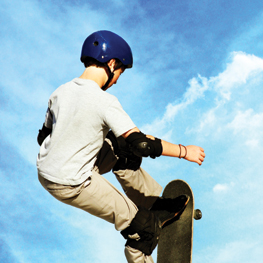
Does your budding baseball catcher use heat-resistant gear? Do your football player’s shoulder pads wick away sweat to help control body temperature? Will gel pads in gloves ease the sting to your softball player’s hand? Do your junior athletes wear face shields made from titanium and stainless steel, and goggles tested for their specific sport?
Sports equipment has undergone revolutionary innovations in recent years, and these high-tech creations are not reserved for the pros. More than half of young athletes’ parents today report that their children under age 21 specialize in a single sport. That requires intense training and extended hours using repetitive motions - and increases the need to purchase special equipment.
Naturally, parents want their children to have the best and safest products. That’s good because injuries to the mouth and face are as much of a worry as a concussion, heat-related injury and broken bones or torn ligaments, according to a recent survey.
If your family is typical, mom purchases 75 per cent of all sports apparel and protective gear, so you should know what the dangers are and what products offer the best protection.
Here’s the scoop on preventing specific sports-related injuries:
Eye injuries - More than 40,000 people are treated for potentially blinding sports-related eye injuries every year, with almost one-third of them children between the ages of five and 14. Prevent Blindness America (PBA) says 90 per cent of the injuries are preventable with proper equipment. Basketball is the worst offending sport, followed by water or pool activities and baseball/softball.
PBA recommends young athletes wear face shields - now available in strong but lightweight materials - and goggles with polycarbonate lenses bearing an ASTM label, indicating they meet the standards of the American Society of Testing Materials for the specific sport.
Mouth injuries - It’s not enough to wear pads for protecting shins and shoulders. The National Youth Sports Safety Foundation estimates that more than 3 million teeth will be knocked out in youth sporting activities this year. A correctly fitting mouth guard is essential for soccer players, who suffer significant injuries to the mouth, jaw and face, according to a study reported in the Journal of Craniofacial Surgery. Although soccer isn’t generally considered a contact sport like football, two-thirds of the injuries in the study occurred when one player ran into another.
Head injuries - Helmets and head gear approved by the ASTM for specific sports 100 per cent of the time are necessary. Players who have sustained a concussion should be withheld from play until all physical and neuropsychological symptoms and signs related to the concussion have been resolved.
Current research by the Institute for Preventative Sports Medicine is focusing on the practice of ‘heading’ soccer balls. Repeated heading can result in permanent information-processing and memory problems, says orthopedic surgeon David Janda, founder of the Institute.
Riding a bicycle, skating and skateboarding are also threats to children younger than 14: There are about 600 bicycling deaths a year, with two-thirds attributed to traumatic brain injury, which is the leading cause of sports and recreation related death.
Helmets or head gear should be worn at all times for baseball and softball when batting, cycling, football, hockey, horseback riding, inline skating, riding skateboards or scooters, skiing, snowboarding, wrestling and when driving or riding on powered recreational vehicles like ATVs.
Prevent injuries
The best protection against injuries is teaching young athletes the fundamentals of their sport, paying attention to proper techniques and adequate conditioning, according to Janda. Since most injuries occur in practices rather than in games, parents should observe practice sessions and encourage coaches to emphasize safety over winning.
Parents or coaches must supervise young children at all times. Because children who are new to a sport are at greater risk of injury, be sure they use sporting equipment properly and only play sports suitable for their age. Perform safety checks of sports fields and equipment regularly, and discard or replace damaged protective gear.
More tips for parents and coaches: Be especially vigilant during hot weather, and take precautions during both practice and games. Breathable clothing made of natural fibres will keep budding athletes cooler. Make sure youngsters avoid the sun when possible and drink water, not caffeinated sports drinks or sodas. Spray or mist skin periodically with cool water. Apply and reapply sunscreen.
Begin hydration immediately for a child who has stopped sweating, who feels lightheaded or dizzy, or has hot, dry, red skin. Seek immediate medical attention for any young athlete who exhibits symptoms of heat-related issues.
Sure, sports are great for fitness, teamwork and self-discipline. But risks are always present, even though they may get lost in the excitement. Sports injuries can cause lasting problems, so be sure an injured child is fully recovered before permitting a return to the playing field.
Beverly writes about health, lifestyle, families and travel for magazines including Women’s Health, Redbook and National Geographic Traveler. Her large family of children and grandchildren unwittingly provide topics for essays published in various Chicken Soup for the Soul books. For more information, visit www.beverlyburmeier.net.
Calgary’s Child Magazine © 2024 Calgary’s Child